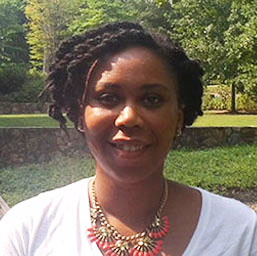Lathiena Manning Alumna Page
Background & Contact Information
Current: Assistant Professor, Pacific Lutheran University
lnervo@plu.edu
Postdoctoral Fellow (2015 – 2019)
Education: Ph.D. 2015 UMBC (Advisor: Michelle Starz-Gaiano)
B.S. Bowie State University
Fellowships & Awards: NIH SPIRE FELLOW (2015-present)
DOE GAANN Fellowship (2013-2015)
IMSD Meyerhoff Graduate Fellow
Email: lmanning@unc.edu
DOWNLOAD CV
INSERT RESEARCH IMAGE HERE. To do so, highlight all the text in this box and then click on the media uploader. ALIGN RIGHT.
Research Information
The focus of my project is to define the mechanisms regulating the interaction between cytoskeletal proteins and adhesion molecules role in shaping epithelial tissue architecture during normal development, using embryogenesis in Drosophila melanogaster as a model. During the latter half of embryogenesis, the lateral epidermis migrates to fully enclose the embryo, in concert with apical constriction of the amnioserosa cells. Dorsal closure provides a model of collective cell migration and wound healing that requires cooperation between the actomyosin cytoskeleton and cadherin based adhesion. A number of key cell biological events contribute to this process. The lateral epidermal cells at the leading edge assemble a contractile cytoskeletal cable linked to adherens junctions. These leading edge cells must regulate actin polymerization and the activity of myosin motor proteins to create a contractile force; simultaneously they are generating dynamic filopodia in the direction of migration. While the lateral epidermal cells are migrating, the amnioserosa cells are undergoing apical constrictions driven by junctional belts of actomyosin. The amnioserosa cells use tension based dynamics to control pulses of the actomyosin cable, which aid to pull the surrounding lateral epidermal tissue dorsally. The actomyosin network is necessary in both the amnioserosa and lateral epidermal cells for to create forces necessary for dorsal closure. My main objective is to discern which proteins regulate contractile forces in the leading edge and amnioserosal cells and how these forces contribute to the closing of the lateral epidermis. I am focusing on distinct regulators of actin and adheren junction interactions. The actin binding protein Canoe/Afadin mediates adheren junction and actomyosin linkage. Previous work done in the lab has shown Canoe mediates actomyosin linkage causing periodic apical constrictions during germband extension and is required for mesoderm invagination. The loss of Canoe results in apical and cortical actomyosin detachment from the zonal adhesion molecules. In mammalian cell culture we found that Afadin is recruited to zonula adhesions and is essential for a response to increased contractile forces across the cell monolayer. Based on these results I will use a cross disciplinary approach combining genetic manipulations and superresolution microscopy to define the mechanisms by which Canoe regulates cell shape changes requiring actomyosin contractile forces, using dorsal closure as a model. This work will also provide insight into putative targets that contribute to the tissue morphogenetic activities required during wound healing.
Publications
- Manning, L.A., Perez-Vale, K.Z., Schaefer, K.N., Sewell, M.T., Peifer, M. (2019). The Drosophila Afadin and ZO-1 homologs Canoe and Polychaetoid act in parallel to maintain epithelial integrity when challenged by adherens junction remodeling. Molecular Biology of the Cell 30, 1938-1960.
- Manning, L.A., and Peifer, M. (2019). Getting into shape: tissue tension drives oriented cell divisions during organogenesis. EMBO Journal 38, e101246.
- Manning L, Sheth J, Bridges S, Saadin A, Odinammadu K, Andrew D, Spencer S, Montell D, Starz-Gaiano M. (2017) A hormonal cue promotes timely follicle cell migration by modulating transcription profiles. Mech Dev. 148:56-68.
-
Manning LA, Weideman AM, Peercy BE, Starz-Gaiano M. (2015) Tissue landscape alters adjacent cell fates during Drosophila egg development. Nat Commun. 6:7356. doi: 10.1038/ncomms8356.
-
Stonko DP, Manning L, Starz-Gaiano M, Peercy BE. (2015) A mathematical model of collective cell migration in a three-dimensional, heterogeneous environment. PLoS One. 10:e0122799. doi: 10.1371/journal.pone.0122799
- Manning L, Starz-Gaiano M. (2015) Upright imaging of Drosophila egg chambers. J Vis Exp. 13;(97). doi: 10.3791/52636.
- Manning L, Starz-Gaiano M. (2015) Culturing Drosophila Egg Chambers and Investigating Developmental Processes Through Live Imaging. Methods Mol Biol. 1328:73-88. doi: 10.1007/978-1-4939-2851-4_5.



